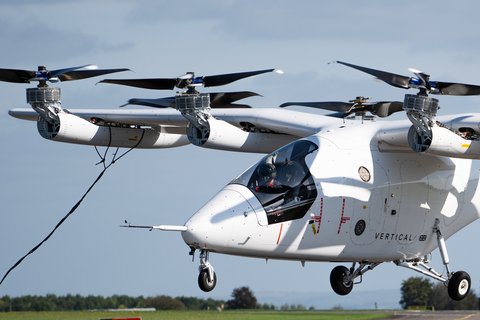Vertical's New VX4 Prototype Completes Phase 1 of Piloted Testing
- Phase 1 included tethered flights, ground taxi testing and high-powered ground runs, all with a pilot on board.
-
Vertical is now preparing to progress to piloted untethered thrustborne testing, as soon as it receives permission from the
UK Civil Aviation Authority (CAA). - The VX4 went from its first powered ground test to 'wheels up’ in just one week – three times faster than the previous prototype.

Vertical's Chief Test Pilot flys the latest VX4 prototype during phase one of its flight test programme in September. (Photo: Buiness Wire)
During Phase 1, the VX4 prototype conducted multiple piloted tethered flights and ground runs, across 20 piloted test sorties, completing a total of 70 individual test points. Together, these tests simulated various aspects of flight and operational situations needed to validate the prototype’s safety in real-world flight scenarios, including those outside of its expected operating conditions. By intentionally testing the aircraft's ability to handle failures, Vertical demonstrated the underlying safety of its design.
One of the most important tests successfully carried out included simulating the failure of one Electric Propulsion Unit (EPU) – inoperative testing – while in piloted tethered flight, to ensure the aircraft responds correctly and continues to be safe while in flight conditions.
These tests have enabled Vertical engineers to collect and measure 35,000 flight and system parameters and verify that all systems are operating correctly and safely in different conditions ahead of further expanding the flight test envelope to piloted thrustborne flight.
Alongside Phase 1 testing, Vertical’s engineers also completed more advanced low and high-speed taxi tests, including deliberately failing EPUs at high taxi speeds to confirm controllability and safety. This verified ground handling characteristics throughout the taxi envelope, as well as aerodynamic characteristics for increasing speed, while in a safe, ground test environment.
Vertical is continuing to work closely with the
Vertical is currently developing an identical full-scale prototype which will accelerate the VX4’s flight test programme and demonstration capability. The company will take flight test learnings from both prototypes into the design and development of the certified VX4 model.
CEO of Vertical Aerospace, Stuart Simpson, said:
“It took us just one week to go from our first ground test to our chief test pilot flying the VX4, and we have been making outstanding progress since then. We continue to prove the safety and performance of our design and technology, which we believe to be market leading. Completing this first phase of testing is a significant feat for any eVTOL company and shows the strength of our aircraft, team, and our partners as we progress through our flight test programme and head towards our goal of creating a better way to travel.”
Phase 1 of testing included:
- Piloted tethered flight: performed using closed loop flight control to ensure the aircraft's stability and safety in a controlled environment. Also included simulated failure testing to validate one EPU deliberately failing and assessing automatic aircraft response to bring other engines to maximum power output while in tethered flight.
-
Ground vibration testing (GVT): Working with specialists from world leading ATA Engineering – who performed GVT testing on the
$10 billion - Powertrain testing: Understanding how the powertrain is operating and evaluating all the components that generate and deliver power to the propellors. This includes a High Voltage (HV) ripple test to measure and analyse voltage fluctuations (ripple) generated on the powertrain and ensuring the battery can handle it, even at low charge, while providing a stable power supply. This is carried out while the aircraft is tethered in hover.
- Dynamic testing: Ensuring all systems are functioning correctly before they are put into use in flight in real-life conditions – such as powering up, checking the parts are installed and connected correctly and the systems and components work.
- Propellor testing: Propeller balancing and spinning tests to measure weight distribution of each propeller blade to ensure vibrations are minimised for smooth, stable flying.
- Taxi testing: VX4 is piloted at low and high speeds on the ground to test the aircraft can move forwards and backwards effectively, testing brake performance and direction of control using differential thrust.
Notes to Editors
Piloted flight test programme explainer:
- Phase 1: Tethered: the VX4 will perform stabilised hover while loosely tethered to the ground - COMPLETE
- Phase 2: Thrustborne: the VX4 will take-off and land vertically and conduct low speed flight manoeuvres with lift generated by the propellers.
- Phase 3: Wingborne: the VX4 will take-off, fly and land like a conventional aircraft, with lift generated by the wing.
- Phase 4: Transition: The VX4 will transition between thrustborne and wingborne flight, and vice versa.
New VX4 prototype
This next-generation VX4 is more powerful than the previous full-scale prototype, with an impressive
The aircraft has been designed and built alongside global aerospace partners, including GKN Aerospace, Honeywell, Hanwha, Molicel, Leonardo and Syensqo. It features Vertical’s next generation propellers and new proprietary battery technology, capable of delivering 1.4 MW of peak power and which has been designed and built at the state-of-the-art Vertical Energy Centre near
About Vertical Aerospace
Vertical Aerospace is a global aerospace and technology company pioneering electric aviation. Vertical is creating a safer, cleaner and quieter way to travel. Vertical’s VX4 is a piloted, four passenger, Electric Vertical Take-Off and Landing (eVTOL) aircraft, with zero operating emissions. Vertical combines partnering with leading aerospace companies, including GKN, Honeywell and Leonardo, with developing its own proprietary battery and propeller technology to develop the world’s most advanced and safest eVTOL.
Vertical has 1,500 pre-orders of the VX4 worth
Headquartered in
Forward-Looking Statements
This press release contains forward-looking statements within the meaning of the
View source version on businesswire.com: https://www.businesswire.com/news/home/20240912188188/en/
Justin Bates, Head of Communications
justin.bates@vertical-aerospace.com
+44 7878 357 463
Source: Vertical Aerospace








